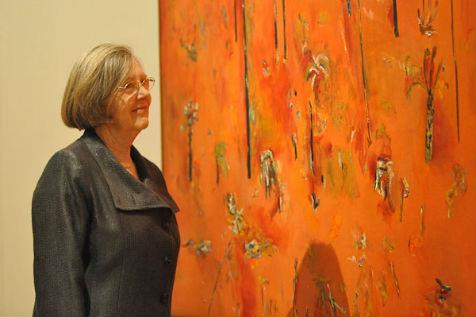The artworks left behind when an artist dies are invested with multiple meanings. Beyond being the widow’s most valuable potential income stream, they are a tangible repository of memories; the last physical proof of a lost loved one.
Promoting the work now has emotional, financial and reputational spin-offs, so it’s no surprise that the human tendency towards eulogising the dead, forgetting their foibles and emphasising their virtues, comes to the fore. Couples who were partly estranged, on the verge of breaking up, or even separated, can become very much together once the artist has died, the messy, difficult aspects of their life story pushed to one side.
‘It’s like being a super barrister, isn’t it?’ muses Barry Pearce, the former long-time head of Australian art at the Art Gallery of New South Wales. ‘The widow is the super barrister. You take on the case and you believe it.’
Questions of what to sell and when and how to sell it will arise, and if the artist is revered there will also be the issue of what to donate, when and to where. The federal government’s cultural gifts program, which offers a tax deduction for works gifted to public collecting institutions, will become a useful way to offset the income earned from sales and thus reduce a tax bill. What to do with the studio, if and when to push for a book, a retrospective, a name on a gallery wall; these are all issues the widow will grapple with.
The perennial problem of fakes may arise, and copyright concerns—when to allow usage and when to withhold it, when to charge and how much—will become a new constant in life. So, too, will the resale royalty, which mandates 5 per cent of the price of some works sold on the secondary market goes to the artist or their estate. Introduced in mid 2010, this royalty is coming in gradually. Over time it will put substantial monies into the pockets of the biggest sellers on the secondary market, and that means artists’ estates.
It is not only widows who are left with the privilege and burden of handling an artist’s estate. In some cases, such as for sculptors Gascoigne and Robert Klippel, the artists’ children have responsibility. In other instances a small group of close associates take on the role, as is the case for William Dobell, who never married or had children, and Bedford, an Aboriginal painter who lived in remote Australia. And in yet other cases control of an estate can unexpectedly land with an ex-partner. Huon Hooke had broken up with Oliver five weeks before she died but now handles the sculptor’s legacy; Wendy Whiteley took control of ex-husband Brett Whiteley’s estate after their daughter Arkie died in 2001.
What these keepers of the flame do can have a real effect on the artist’s reputation, as well as their own financial security. Do too little and the artist can drop out of sight and favour. When George Baldessin died in 1978 he was as well known and lauded in Melbourne as Brett Whiteley was in Sydney. A subsequent, devastating blow meant his widow, Tess, left Australia five years later, and did very little with the estate over the following two decades. She did not return permanently until late 2000, when she found that Baldessin had largely fallen from public view.
Roger Kemp’s wife, Merle, could not bear to part with many of his paintings after the artist’s death in 1987; the couple’s daughter, Michel, concedes that her job may have been easier if there had been a more consistent release of works from the estate in the first decade after her father’s death.
On the flip side, if too much is done too quickly there is a risk of flooding the market and depressing prices. The lion’s share of what was left in William Dobell’s studio was sold off in a gala auction at the Sydney Opera House in 1973. While the sale did exceptionally well, Dobell’s prices fell the following year. Add to this changing tastes and the fact that his best paintings are tightly held, and Dobell does not fetch anywhere near the prices of Brack, Williams or Whiteley at auction today. It may have been savvier to sell the works left in his studio over years, or even decades.
Yet selling a large number of works slowly only succeeds in a rising market, and sometimes the buzz created around a single-owner estate sale can trump the steady-as-she-goes approach. Often there is no right answer, only 20–20 hindsight.
Melbourne art dealers Rod Eastgate and Jillian Holst have helped many families work through how to respond when the artist among them dies. They say it often takes a while for family members to realise that what they do with the artist’s remaining work can make a tangible difference to his or her reputation, particularly if the artist is respected but not a superstar. The best thing for some pieces left in the studio is to make sure they never see the light of day. The studio is where an artist experiments, thus along with completed art there will be unfinished work and pieces the artist never intended to exhibit, either because they were working sketches or because the artist was not happy with them.
Assessing what among all this should be put in front of the public, and how and when to do so, is the lot of those left behind. ‘It’s a full-time job,’ says Eastgate. ‘I often say, ‘Look, give up your part-time job. If you sell one painting, you’ll make more money than you will from a full year’s work. If you address these issues properly, sales will come to the fore and you won’t need to work.’
This article is an extract from Affairs of the Art: Love Loss and Power in the Art World by Katrina Strickland published by MUP, RRP $34.99, available now at www.mup.com.au





